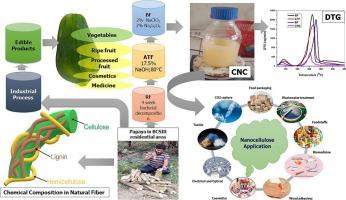Production of cellulose nanocrystal (CNC) from papaya tree stem as a potential reinforcement in bionanocomposite manufacturing
Q1 Environmental Science
引用次数: 0
Abstract
Nowadays, to fabricate polyfunctional bionanocomposite CNCs is very attractive to researchers due to its outstanding properties and eco-friendly features. But in general, CNCs are produced from primary plant-derived fibers, which have several advantageous applications in other sectors. Therefore, to diminish the extreme pressure on primary plants, it is crucial to discover alternative sources of CNCs from secondary plants. While the waste biomass of the papaya tree stem would be an innovative and beneficial candidate for the production of CNCs as a reinforcing agent. In this study, dew retting was applied to extract raw fiber from the papaya tree stem then scouring, alkali modification, chlorite bleaching, H2SO4 hydrolysis reactions were directed for the production of CNCs. To explore the overall purity and structural belongings of the newly produced CNCs they were categorized by XRD, TGA/DTA/DTG, FTIR-ATR, UV–vis-NIR, FESEM, STEM, EDX, DLS, and zeta potential analysis. The outcomes recommended that the produced CNCs have extensive binding sites, greater thermal stability, higher crystallinity (84.51 ± 0.18 %), well-organized mesoporous honeycomb-like microstructure along with a negative surface charge around −19.30 mV. So, this papaya stem-derived CNCs would be constructively applied as a reinforcement to produce polyfunctional bionanocomposites for various uses in several industrial, engineering, and biomedical sectors.

番木瓜树干纤维素纳米晶体(CNC)的生产作为生物复合材料制造的潜在增强材料
目前,多功能生物纳米复合材料以其优异的性能和生态友好的特点成为研究领域的热点。但一般来说,cnc是由原生植物纤维制成的,这在其他领域有几个有利的应用。因此,为了减少对原生植物的极端压力,从次生植物中发现CNCs的替代来源至关重要。而木瓜树干的废弃生物质将是生产CNCs作为补强剂的创新和有益的候选物。本研究以木瓜树干为原料,采用露晶法提取其原纤维,然后通过精练、碱改性、亚氯酸盐漂白、H2SO4水解等反应制备cnc。采用XRD、TGA/DTA/DTG、FTIR-ATR、UV-vis-NIR、FESEM、STEM、EDX、DLS和zeta电位分析对新制备的cnc进行了总体纯度和结构特征分析。结果表明,制备的cnc具有广泛的结合位点,更高的热稳定性,更高的结晶度(84.51±0.18%),组织良好的介孔蜂窝状结构,表面负电荷约为- 19.30 mV。因此,这种木瓜茎衍生的cnc将被建设性地应用于生产多功能生物纳米复合材料,用于工业、工程和生物医学领域的各种用途。
本文章由计算机程序翻译,如有差异,请以英文原文为准。
求助全文
约1分钟内获得全文
求助全文
来源期刊

Bioresource Technology Reports
Environmental Science-Environmental Engineering
CiteScore
7.20
自引率
0.00%
发文量
390
审稿时长
28 days
 求助内容:
求助内容: 应助结果提醒方式:
应助结果提醒方式:


